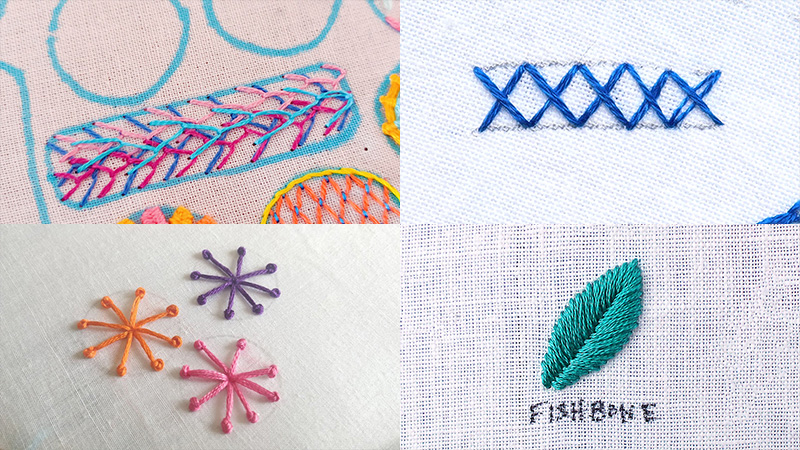
Embroidery, a timeless craft with roots stretching back through history, combines precision and artistry to adorn fabric with intricate designs. Utilizing a needle and thread, this technique transforms ordinary cloth into a canvas of beauty.
With applications ranging from fashion to interior décor, embroidery’s allure is undeniable. Across centuries, countless stitches have evolved, each possessing its own narrative and purpose.
This article delves into the rich world of embroidery stitches, exploring their diverse forms and the creative avenues they open. Join us as we unravel the threads that bind craftsmanship and creativity in the realm of embroidery.
1. Backstitch
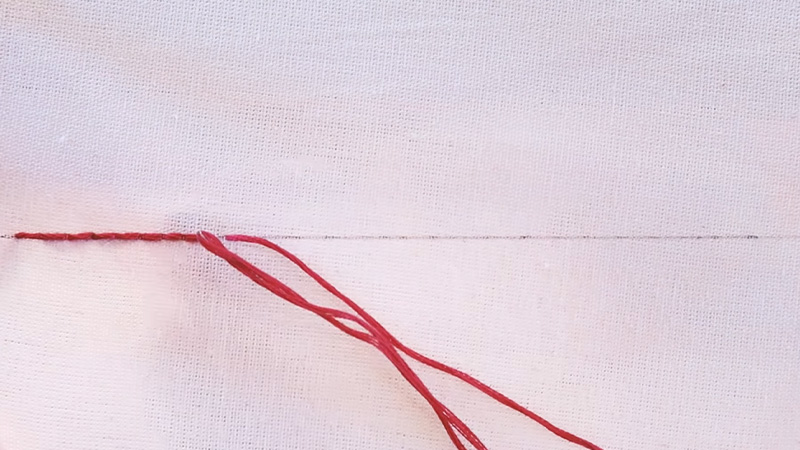
Backstitch, also known as back stitch, and its variants stem stitch, outline stitch and split stitch, are a type of embroidery and sewing stitches that involve making individual stitches in the opposite direction of the general direction of the sewing.
Backstitch is a versatile and strong stitch, which is why it is used extensively in hand sewing and embroidery. The backstitch is created by taking two or more stitches in the same direction, and then stitching back in the previous stitch.
This creates a line of stitches that looks like a series of backward ‘S’ shapes.
Depending on the fabric, a backstitch may be visible from both the front and back of the fabric, or just from the back. Stem stitch is a type of backstitch where the stitches are worked in a curved line.
This is often used to create smooth outlines and curves.
Outline stitch is similar to stem stitch, but the stitches are worked in a straight line.
Split stitch is a backstitch where each stitch is worked through the middle of the previous stitch, creating a slightly raised line.Backstitch and its variants are strong and useful stitches and are used in many types of sewing and embroidery projects.
They can be used to create decorative borders, and outlines, or simply to join two pieces of fabric together. They are also popular for creating lettering, monograms, and other textured designs.
2. Satin Stitch
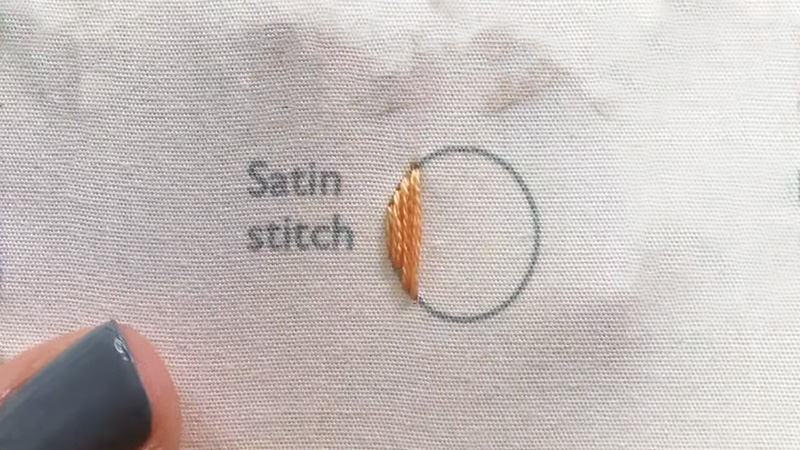
Satin stitch, also known as damask stitch, is a type of embroidery stitch used to completely cover a section of the background fabric. It is a series of flat stitches laid close together in narrow rows.
Satin stitch can be accomplished on a regular sewing machine, either with a zigzag stitch or a special satin stitch foot. The special satin stitch foot is designed to keep the stitches even, as it can be difficult to maintain the same stitch width if done manually.
Additionally, this type of foot allows for the stitch to be adjustable, so you can customize the look of the stitch. Satin stitch is commonly used for decorative purposes, such as adding a pattern or image to fabric, or for making a design stand out, such as around a buttonhole.
It is also often used to fill in areas of an embroidery design, such as in floral patterns or lettering.
3. Chain Stitch
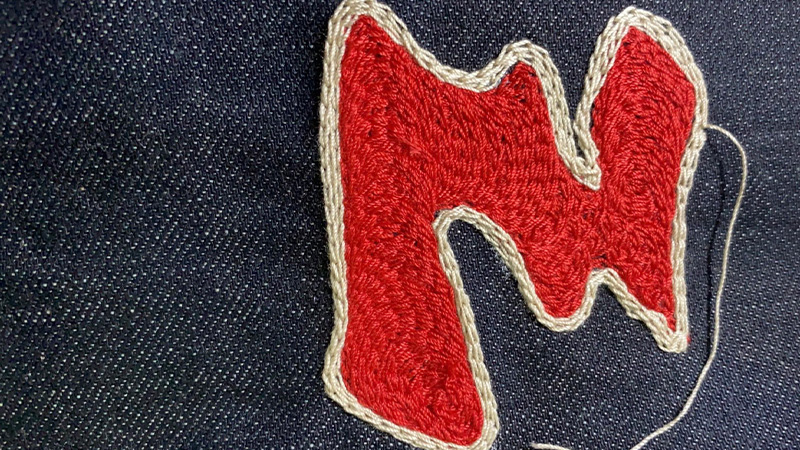
Chain stitch is a unique technique used in both sewing and embroidery. It involves making a series of looped stitches that create a chain-like pattern.
This ancient craft is believed to have originated in China, as evidenced by surviving examples of Chinese chain stitch embroidery that have been found and dated back to the Warring States period.
These embroideries were usually worked in silk thread, a material that was associated with luxury at the time. Chain stitch is still used today, and can be used to create a variety of patterns and designs.
It is often used to create intricate floral patterns or decorative borders.
The use of multiple colors of thread can also add depth and texture to the finished embroidery. Chain stitch is an ideal choice for those looking to create beautiful embroidery pieces with a timeless look.
It is relatively simple to learn and can be used to create both simple and complex designs. With a bit of practice, anyone can learn to create stunning embroidery pieces with chain stitches.
4. Straight Stitch
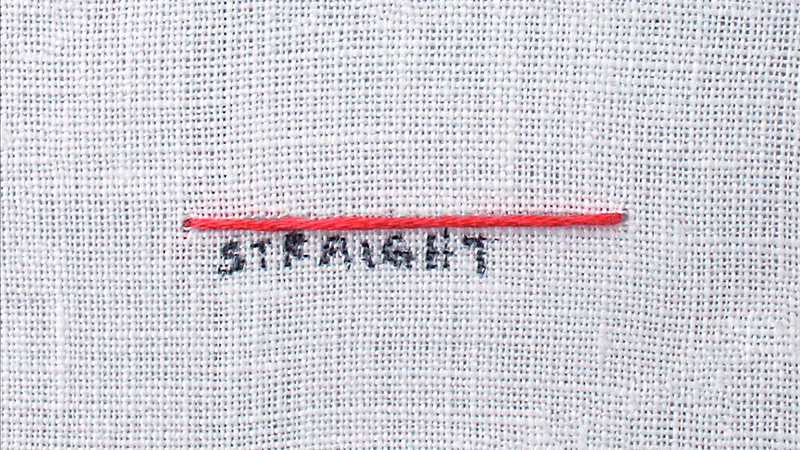
The straight or running stitch is the most basic and essential stitch when it comes to hand-sewing and embroidery. It is commonly used to sew two pieces of fabric together and is created by passing the needle in and out of the fabric at a regular distance.
This stitch is the foundation for creating other more complex forms of sewing. By varying the length, spacing, and direction of the straight stitch, other more intricate stitches can be created.
For example, the backstitch is created by taking two stitches forward and one stitch back, creating a more secure and durable seam. The buttonhole stitch is created by making a series of small straight stitches in a circular shape, allowing for the secure attachment of buttons.
Other stitches, such as chain stitch and blanket stitch, are also created by varying the straight stitch in one way or another. No matter what type of stitch is used, the straight stitch is the basic building block from which all other stitches are formed.
5. Split Stitch
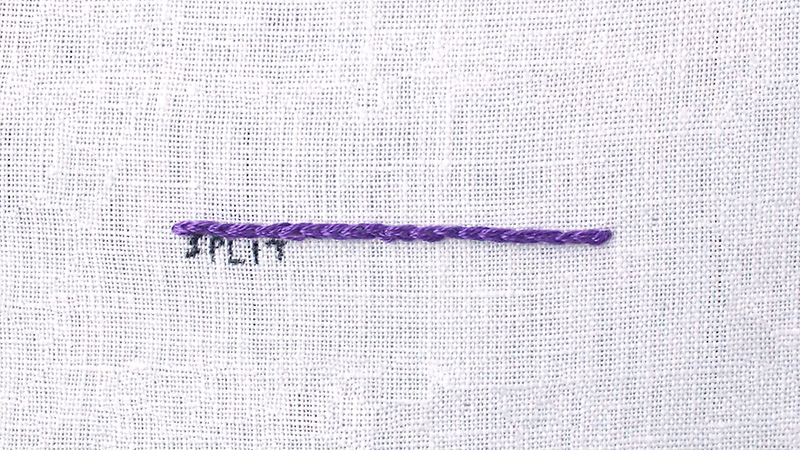
The split stitch is a charming embroidery technique that adds texture and depth to designs. To create this stitch, bring the needle up through the fabric and then insert it back down, splitting the thread in half.
With each new stitch, pass the needle up through the middle of the previous stitch, splitting the thread again. The result is a delicate line resembling a twisted rope, perfect for outlining or adding intricate details.
The split stitch offers a unique touch to your embroidery projects, elevating them with its textured elegance.
6. Feather Stitch
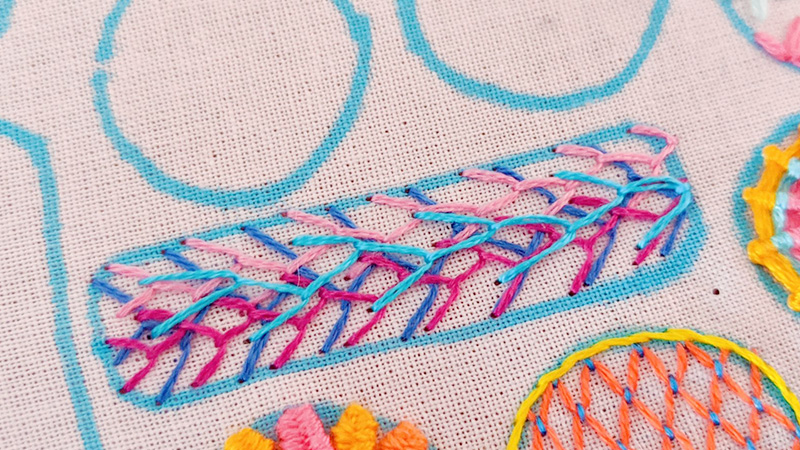
Feather stitch and Cretan stitch are both embroidery techniques that involve the use of looped stitches that are worked alternately to the right and left of a central rib.
Both techniques are open stitches, which means that when worked correctly, they create an open, lacy fabric.
The looped stitches of the featherstitch and Cretan stitch form a zigzag pattern which creates a beautiful texture. Fly stitch is also categorized with featherstitches, as it is comprised of the same types of looped stitches.
However, the fly stitch is slightly different, as it is worked in a circular pattern instead of a zigzag pattern. This creates a more intricate, detailed design that can be used to add a unique look to any embroidered piece.
7. Cross-stitch
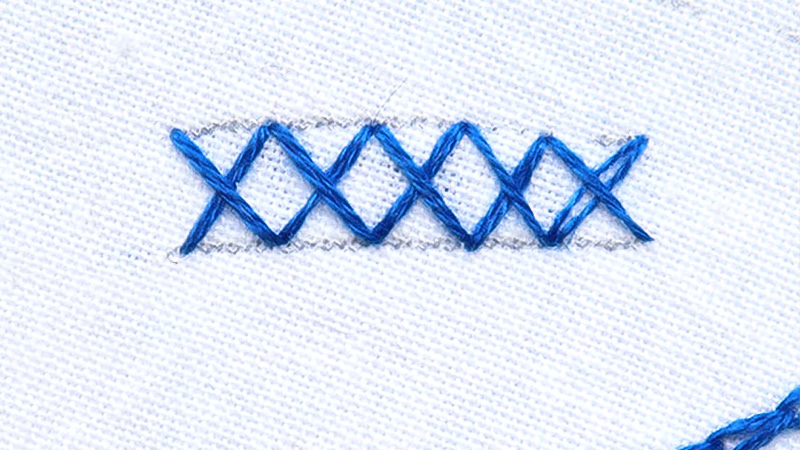
Cross-stitch is a type of sewing that produces beautiful embroidery designs. It is a type of counted-thread embroidery, which means that the number of threads used in the fabric are counted in each direction in order to create a pattern of uniform size and appearance.
It involves using X-shaped stitches to create a raster-like pattern, which together creates a picture. This type of embroidery is popular with both hobbyists and professionals because it is relatively easy to learn and can produce stunning results.
The stitcher must be careful to count the threads in the fabric so that the stitches are even, and the overall pattern looks neat and consistent. With a bit of practice, anyone can create stunning embroidery designs using cross-stitch.
8. Fly Stitch
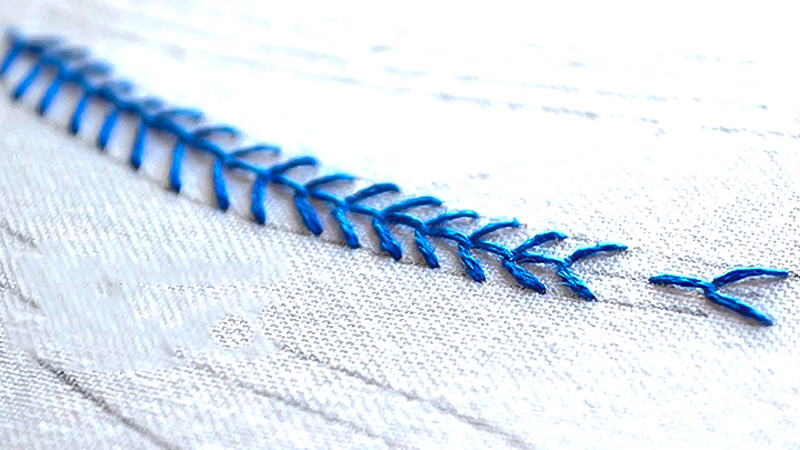
The fly stitch is a versatile embroidery stitch that resembles a flying bird with outstretched wings. To execute this stitch, start by bringing the needle up through the fabric.
Then, insert the needle back down at a slight angle, creating a diagonal stitch. Next, bring the needle up a short distance away from the first stitch and pass it through the loop created by the diagonal stitch, anchoring the loop down.
The result is a V-shaped stitch with an open center. Fly stitches can be used individually for decorative accents or combined in rows to form leaves, petals, and more. This stitch adds movement and flair to your embroidery projects.
9. Chain

A chain is an assembly of pieces, known as links, that are connected to one another in a linear formation. The links are typically made from metal, providing an overall character that is similar to rope.
This is because the chain is flexible and can bend when under compression, but is rigid and can bear a load when tension is applied. Chains can be comprised of two or more links, which vary in size and shape depending on the application.
Generally, the stronger and thicker the links, the greater the weight and pressure the chain can withstand. Chains are used in a variety of applications, such as for lifting, towing, and suspending objects.
Chains are also used to drive machinery, such as gears, sprockets, and pulleys. Chains can also be used in decorative applications, such as necklaces and bracelets.
10. Running Stitch
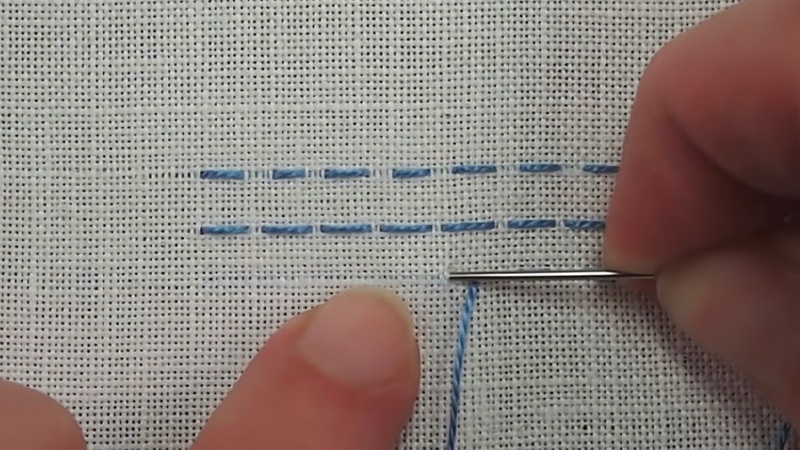
The running stitch is a fundamental embroidery stitch known for its simplicity and versatility. To create this stitch, bring the needle up through the fabric and then insert it back down a short distance away.
Repeat this process, forming a line of evenly spaced stitches. The running stitch is often used for basic outlines, basting, and adding subtle texture.
While straightforward, its impact on embroidery is significant, offering a clean and minimalistic aesthetic. Whether used as a standalone element or as a foundation for more complex stitches, the running stitch remains an essential technique in the world of embroidery.
11. Lazy Daisy Stitch
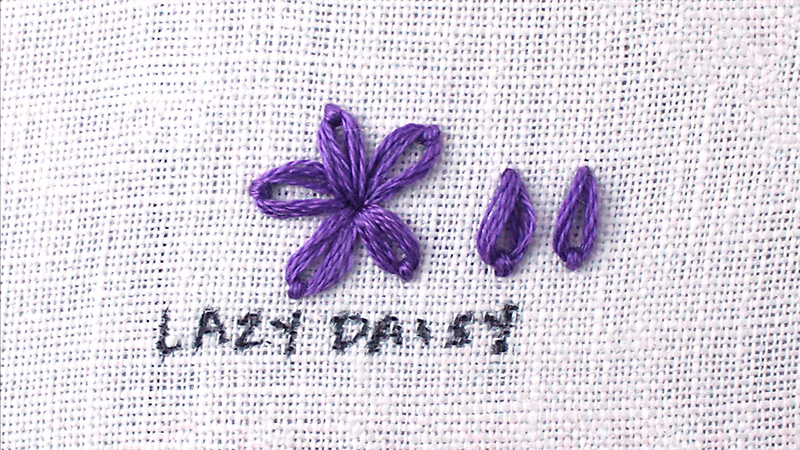
The lazy daisy stitch, also known as the detached chain stitch, is a charming and versatile embroidery technique that forms delicate flower petals, leaves, and more.
To craft this stitch, start by creating a small loop on the fabric’s surface and anchoring it with a tiny stitch at the loop’s base. This loop resembles the petal or leaf.
Repeat the process to craft multiple loops side by side, creating a chain of charming petals or leaves. The lazy daisy stitch adds a whimsical and playful touch to embroidery projects, making it perfect for floral motifs and embellishments that require a hint of sweetness.
12. Couching Stitch
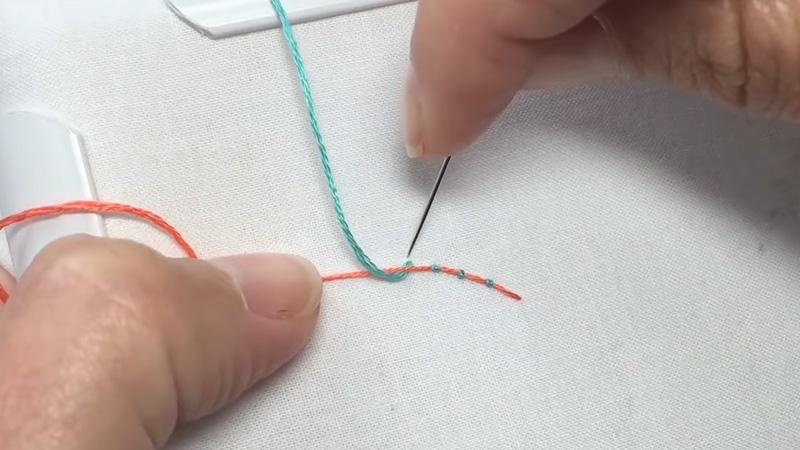
The couching stitch is an embroidery technique that involves securing one thread or fiber onto the fabric surface using another thread. This versatile stitch is used to create textured lines, outlines, and intricate designs.
To execute the couching stitch, lay the thread to be couched on the fabric and hold it in place with small stitches of a contrasting thread, forming a decorative pattern or shape.
This technique allows for the use of thicker threads, yarns, or even ribbons, adding dimension and texture to the embroidery piece. The couching stitch is a creative way to incorporate diverse materials and achieve intricate effects in your embroidery artwork.
13. Herringbone Stitch
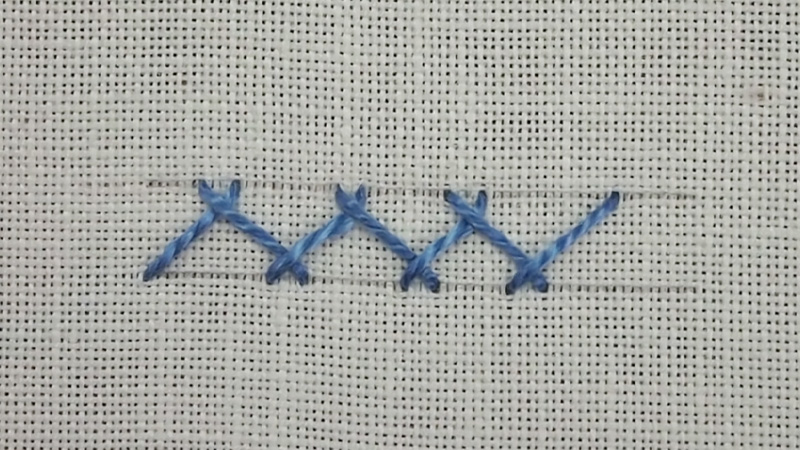
A herringbone stitch is a type of needlework used in a variety of crafts, including embroidery, knitting, and crochet. It is named after the herring fish due to the stitch’s resemblance to the bones that extend from the spine of the fish.
When used in knitting, the herringbone stitch creates a fabric pattern that closely resembles herringbone cloth, which is a type of fabric that is woven with a distinctive twill pattern.
The stitch uses a weaving technique, where the yarn is looped over the needle, and then worked in a twill pattern. This results in a fabric that is both strong and flexible, making it an ideal choice for a variety of projects.
The herringbone stitch has a timeless look that is both classic and modern, making it a popular choice for both beginners and experienced crafters alike.
14. Woven Wheel Stitch
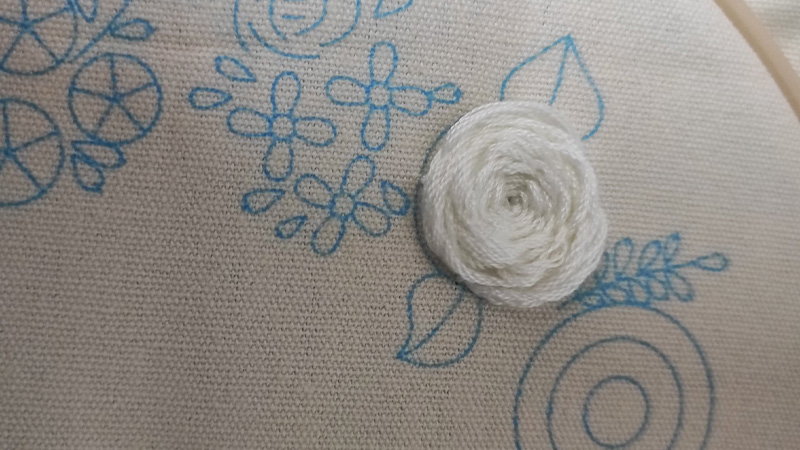
The woven wheel stitch, also known as the woven rose stitch or spider web stitch, is an enchanting embroidery technique that creates intricate circular designs resembling flowers or wheels.
To achieve this stitch, start by creating a small central stitch on the fabric. Then, form evenly spaced straight stitches around the central point, radiating outward like the spokes of a wheel.
As you add more spokes, weave the working thread over and under the spokes in a circular manner. This weaving creates a captivating textured effect that resembles a woven wheel or a blooming flower.
The woven wheel stitch is perfect for adding elegance and detail to your embroidery projects, making them truly stand out.
15. Fishbone Stitch
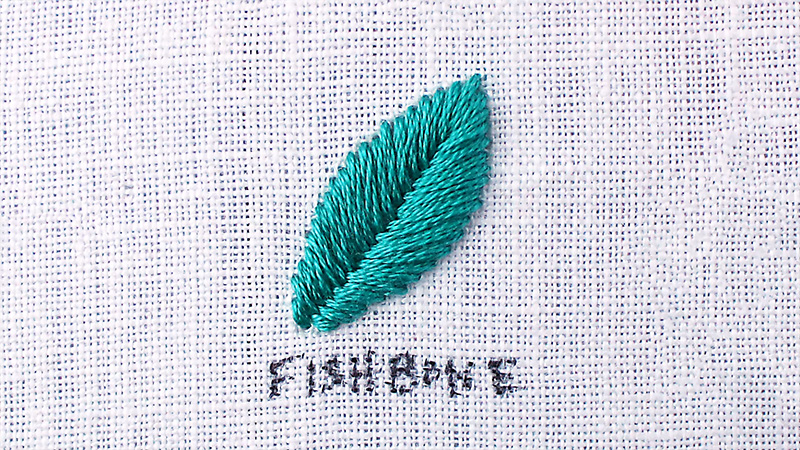
The fishbone stitch is an embroidery technique that mimics the shape of fishbones and is often used to create leaves, feathers, and other tapered elements.
To craft this stitch, begin by making a straight stitch at the center of the leaf or shape. Next, create a diagonal stitch from one side of the center stitch to the outer edge of the shape.
Repeat this process on the opposite side, forming a V-shaped pattern that resembles a fishbone. Alternate the stitches on both sides of the center to create a realistic and textured effect, giving the appearance of overlapping and layered elements.
The fishbone stitch adds a lifelike dimension to your embroidery, making it a popular choice for botanical designs and detailed accents.
16. Buttonhole Stitch
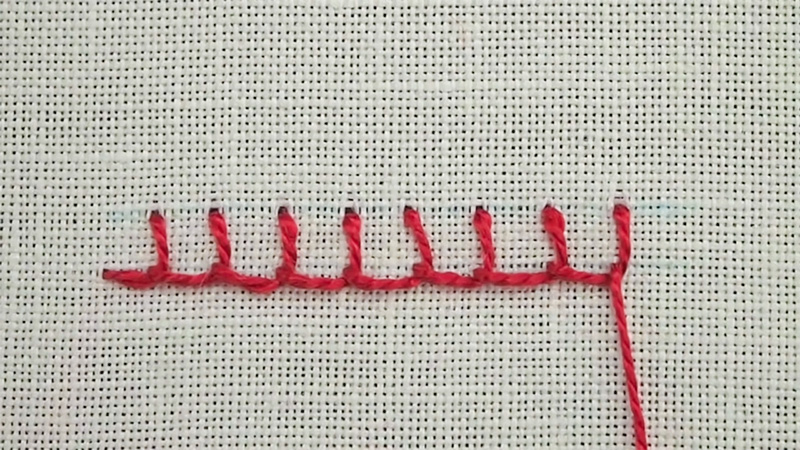
The buttonhole stitch and the blanket stitch are two of the most useful and versatile hand-sewing stitches. They are used in a variety of sewing applications, including tailoring, embroidery, and needle lace-making.
The buttonhole stitch is used to make a neat, secure edge on a fabric, such as the edge of a pocket, and is also used for decorative purposes.
The blanket stitch is used to secure two pieces of fabric together, such as when making a quilt or a blanket, as well as for decorative purposes. Both stitches are relatively easy to learn and can be used to create beautiful and unique designs.
They are also great for mending and reinforcing delicate fabrics. With a bit of practice, these two stitches can be used to create a variety of beautiful and unique pieces.
17. Chevron Stitch
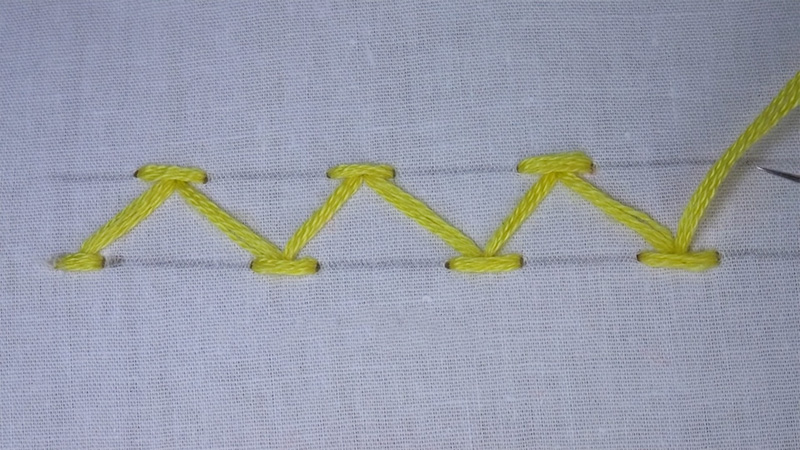
The chevron stitch is a captivating embroidery technique that creates a zigzag pattern resembling a series of interconnected V shapes. This stitch is ideal for adding texture and dynamic movement to your designs.
To execute the chevron stitch, start by creating a horizontal base line of straight stitches. Then, working from left to right or vice versa, form V-shaped stitches that intersect with the base line.
Each new V-shaped stitch starts from the center of the previous one, creating a pleasing chevron effect. This stitch can be adjusted to create varying widths and lengths, offering versatility in your embroidery projects.
The chevron stitch lends a sense of energy and flair, making it a fantastic choice for borders, decorative accents, and visually captivating patterns.
18. Fern Stitch
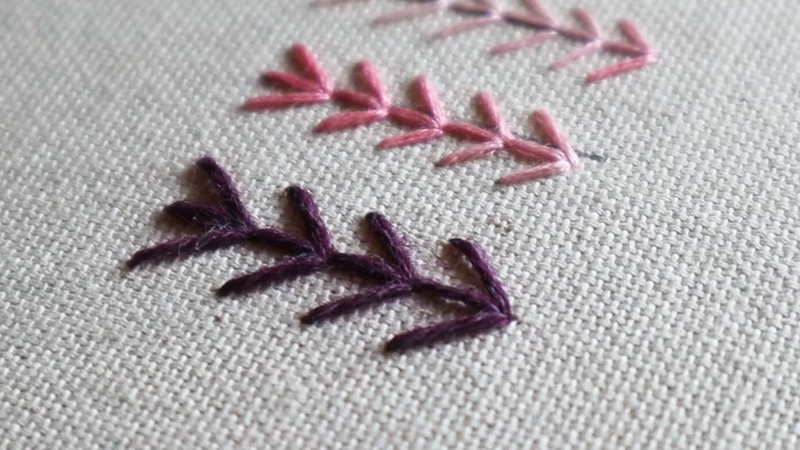
The fern stitch is a delicate embroidery technique that imitates the feathery fronds of a fern plant. This stitch is commonly used to create foliage, leaves, and natural textures in embroidery designs.
To craft the fern stitch, start by making a straight stitch that slants diagonally upward from the base. Then, on one side of the stitch, create smaller angled stitches that radiate outward, resembling the branches of a fern.
Repeat this process on the other side of the central stitch, mirroring the pattern. The result is a charming arrangement of stitches that captures the elegance of fern leaves.
The fern stitch brings a touch of nature’s beauty to your embroidery, perfect for floral designs and nature-inspired motifs.
19. Stem Stitch
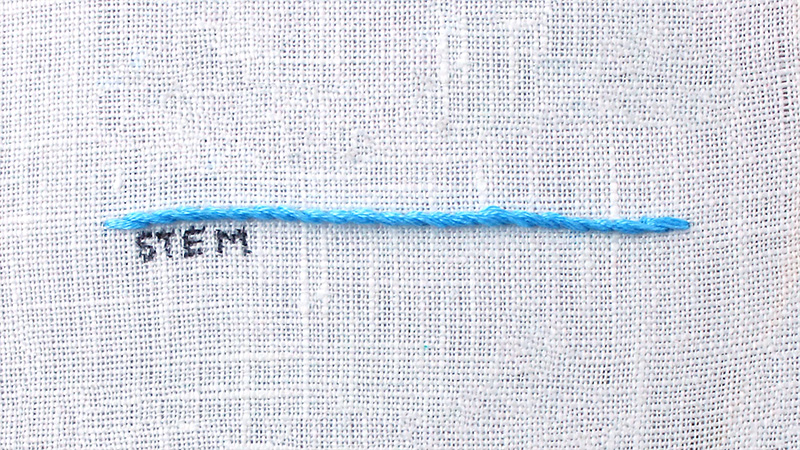
The stem stitch is a classic and versatile embroidery technique used for creating smooth, flowing lines and outlines. This stitch is often employed to depict stems, vines, lettering, and curved elements in embroidery designs.
To achieve the stem stitch, bring the needle up through the fabric and then insert it back down slightly ahead of the starting point. As you bring the needle up again, pass it through the previous stitch, splitting the thread.
This creates a continuous line of interlocked stitches that resemble a twisted rope. The stem stitch is known for its graceful appearance and flexibility, making it a go-to choice for both simple and intricate designs.
20. Colonial Knot
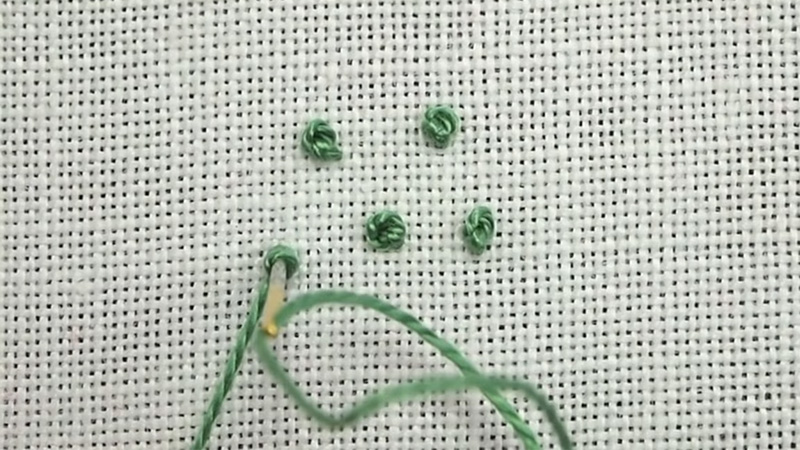
The colonial knot is an embroidery technique used to create small, rounded knots that are ideal for adding texture and dimension to your designs. Similar to the French knot, the colonial knot offers a distinct appearance and is commonly used in intricate details.
To create a colonial knot, insert the needle from the back of the fabric to the front at the desired knot location. Then, wrap the working thread around the needle’s shaft once or twice, depending on the desired knot size.
Hold the thread taut and insert the needle back into the fabric right next to the entry point. Gently pull the thread taut, allowing the wrapped loops to form a neat knot on the fabric’s surface.
21. Pistil Stitch
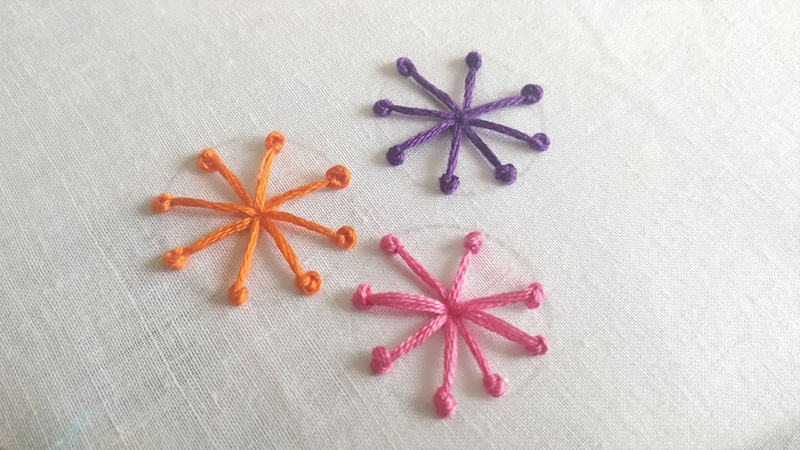
The pistil stitch is an elegant and versatile embroidery technique used to create delicate and realistic floral elements, such as flower centers, stamens, and small buds.
This stitch brings a lifelike quality to your designs, capturing the essence of nature’s beauty. To craft the pistil stitch, start by bringing the needle up through the fabric at the desired center point of the flower.
Then, insert the needle back down into the fabric very close to the entry point, creating a small straight stitch. Next, bring the needle back up through the fabric slightly away from the center point and pass it through the loop created by the straight stitch.
22. Whipped Back Stitch
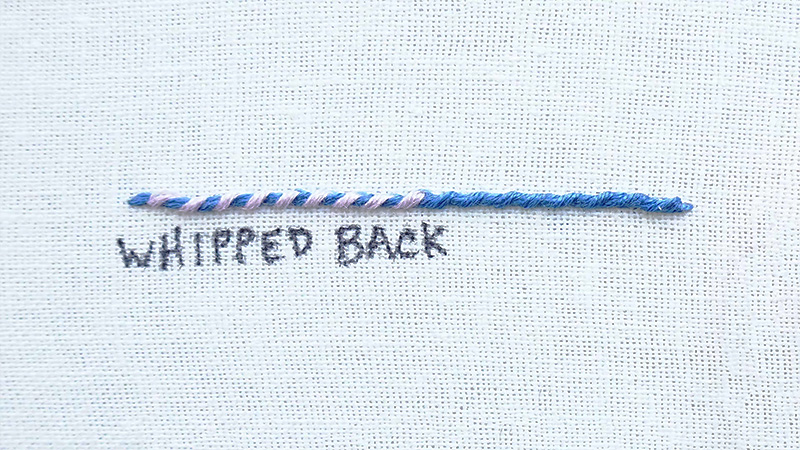
The whipped back stitch is a creative variation of the traditional back stitch, offering a unique and textured look to embroidery designs. To execute this stitch, first create a row of back stitches along the desired path.
Then, using a contrasting thread, whip the stitches by passing the needle over and under the back stitches in a lacing motion. The result is a raised and rope-like effect, perfect for adding dimension and detail.
The whipped back stitch combines the clean lines of the back stitch with the tactile appeal of the whipped texture, making it an excellent choice for borders, outlines, and decorative elements in embroidery projects.
23. Coral

“Coral” in embroidery refers to a technique known as the “coral stitch.” The coral stitch is a unique and eye-catching embroidery stitch that resembles tiny pieces of coral.
This stitch is commonly used for adding texture and interest to various designs, particularly organic and nature-inspired motifs. To create the coral stitch, begin by making a straight stitch from the fabric’s surface.
Then, create loops around the straight stitch by wrapping the thread around it multiple times. The loops should be close together, giving the appearance of coral branches.
This stitch adds a three-dimensional quality to your embroidery, making it an excellent choice for underwater scenes, floral elements, and intricate patterns.
Conclusion
The world of embroidery stitches offers endless possibilities for creativity and expression. As you delve into the diverse range of stitches available, you’ll discover that each stitch brings its own magic to your projects.
From the simplicity of the running stitch to the intricacy of the fishbone or the charm of the lazy daisy, these stitches enable you to transform fabric into art.
With practice, patience, and a willingness to explore, you can master the art of embroidery and use these stitches to craft unique and beautiful pieces.
So, whether you’re adorning garments, decorating home items, or simply enjoying the process, embroidery stitches allow you to leave a distinct mark of your creativity on every project you undertake.
Leave a Reply